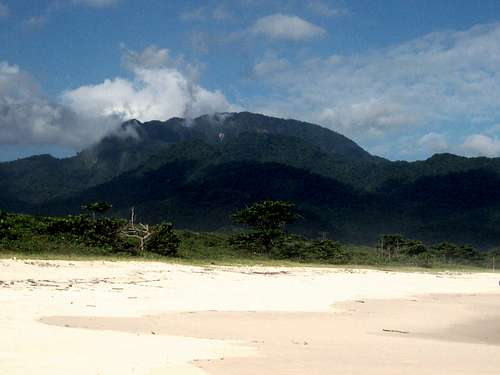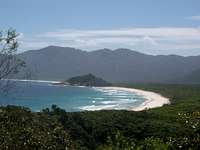-
 9988 Hits
9988 Hits
-
 73.06% Score
73.06% Score
-
 3 Votes
3 Votes
|
|
Area/Range |
|---|---|
|
|
23.14951°S / 44.22143°W |
|
|
Hiking, Mountaineering |
|
|
Spring, Summer, Fall, Winter |
|
|
3383 ft / 1031 m |
|
|
Resume
Ilha Grande ( Big Island ) is one of the brazilian paradises. The Island is covered almost 90% by original Atlantic Forest, one of the last places preserved. Majestic trails, mountains, wild beaches, the perfect place to feel the Nature. Today, Ilha Grande receive more than 8.000 visitors every month. 20 years ago, the number was 600 people per month.Characteristics of Ilha Grande

LOCALIZATION
Brazil, Southeast Region, Rio de Janeiro State, Angra dos Reis town;
Bay of Ilha Grande;
Latitude S: between 23º 05` and 23º 14'
Longitude W: between 44º 05' and 44º 23'
SURFACE AND CONTOUR
193 km² area;
Aprox. Coast Perimeter = 130 km;
Minor perimeter for a coast navigation= 72 km;
The contour is undulating with 34 sharp ends and little peninsulas, 7 small bays and 106 beautiful beaches of diverse characteristics.
RELIEF
Mountainous topography with several peaks. The most important ones are the PICO DA PEDRA D’AGUA with 1031 mts over the sea level and, PICO DO PAPAGAIO with 982 mts. These areas are extensively vegetated and you can also find dense forests, headlands, steeps, plains, rivers and caverns.
CLIMATE
Being an oceanic island, it has a strong influence of the sea over its climate;
It has a tropical weather, very hot and humid. You are not going to find droughts. The medium temperatures of the air are between 15ºC - 30ºC. The medium water temperatures are between 18ºC - 24ºC.
In one year, you have between 180 and 200 sunny days.
According to the Meteorological Station of Andra Dos Reis - INMET-, the annual medium temperature is 22,5ºC, being February, the warmest month with 25,7ºC average and July the coldest, with 19,6ºC.
RAINS - The annual media is 2.242mm, being January the rainiest month with 293 mm and July the driest with 87 mm.
GEOLOGY
The island is situated in the Órgãos Saw, which belongs to the proteozoic era (more than 420-500 millions of years). Its rocks are sintectonic represented by "granitóides".
Belongs to the same group of the Pão de Açúcar of Rio do Janeiro mountains ( Serra da Carioca )
FLORA AND FAUNA
The fauna and the flora are very varied. You will find vegetation from the hills, the coastal, the mangrove and the plains.
Flora: Ilha Grande is inserted into the dense OMBROFILA (of the low lands) grove’s domain known as Atlantic forest. In smaller proportion, the pioneer formations of marine influences (sandbank) and fluvial-marine (mangroves) are one of the most important ecosystems of biodiversity that directly influences the commercial fishing of the area.
Fauna: The Island shelters a lot of rich fauna which is representative of the region. There are lots of bird species, parrots and saracuras. There are different types of monkeys, iguanas, snakes, etc. Some species are already in danger of extinction, as it is the case of the Alouatta fusca, popularly known as monkey Bugio.
Environmental Protection Areas
The whole Island is situated in an Environmental Protection Area called Tamoios (EPA dos Tamoios) and it is also divided into 3 specific areas:PEIG = SPIA = State Park of Ilha Grande.
RBPS = BRSB = Biological Reservation of South Beach.
PEMA = MSPA = Marine State Park of Aventureiro.

The numbers are indicating the principal beaches in Ilha Grande:
1: Vila do Abraão, the main village in the Island;
2: Lopes Mendes
3: Caxadaço
4: Dois Rios
5: Leste
6: Sul
7: Aventureiro ( Adventurer )
8: Proveta
9: Araçatiba
10: Sitio Forte
11: Bananal
STATE PARK OF ILHA GRANDE
This park was created in 1971 and today is being administrated by the SIW (State Institute of Woods). These 4.500 hectares take the shape of a triangle between Abraão, Lopes Mendes and Parnaióca.
This park is a public area protected by the law with the objective to get together men and environment.
It is forbidden to cut down trees, pick plants, capture or feed animals, exercise any agricultural activity, hunt or fish, the mining exploitation and the occupation for residence, commerce or industry. This means that the environment CANNOT BE PREDATED.
BIOLOGICAL RESERVATION OF SOUTH BEACH
It was created in 1981 and is being administrated by the State Foundation of Engineering and Environment (SFEE). 3.500 hectares form a rectangle embracing from the point do Drago to Parnaioca, extending until the slope of the mountains.
This biological reservation shelters all the ecosystems existent in the coastal of Rio de Janeiro. Perhaps this is the only reservation in Brazil with these characteristics.
The objective of the reservation is to preserve the fauna and flora species in danger of extinction.
Visitors are not permitted in this biological reservation. Visits must be only for scientific research and they need to be expressly authorized by the SFEE.
MARINE STATE PARK OF AVENTUREIRO
Is near the Biological Reservation and its borders belong to the whole coastal area and the beaches, from Ponta da Tacunduba (Parnaióca) to Ponta do Drago. It is forbidden to fish, hunt and any other alteration of the environment.
Getting There
It’s very easy to go to Ilha Grande!Driving from Rio de Janeiro:
Take BR-101 and drive to south till Mangaratiba town ( 140 km ) or, Angra dos Reis town ( 175 km ). Angra dos Reis offers best conditions to cross Ilha Grande Bay, with more and confortable ships. Barcas S/A is the official company to make traverses from the Island, two times, every day. The ticket costs US$ 3 and 8 ( weekends ). The ship will go to Abraão beach, the main village. All the trails start in this place. All the trailheads are very well marked with plates and maps. It’s very easy and pleasant to hike and walk by beautiful trails close to the Atlantic Ocean.
Ilha Grande Localization
Trails and Routes
Coming Soon...Camping in Ilha Grande

The wild camping is forbidden in the whole Island. Its preservation and occupation are controlled.There are little inns in whole the Island, with particular areas to camp. It’s cost approx. US$ 10 per day/tent.
FORBIDDEN TO CAMP IN:
Enseada das Palmas, Farol do Castellanos , Lopes Mendes, Santo Antônio, Caxadaço, Dois Rios, Praia de Leste, Praia de Sul, Lagoas Azul e Verde, Praia do Meros, Gruta do Acaiá, Enseada Sítio Forte, Bananal, Freguesia de Santana e Pico do Papagaio. Parnaioca and Aventureiro are ecologial reservations where an authorization is needed to be admitted.
The non observation of the information above can frame you as practicing a transgression of the law on the part of IBAMA and you can be captured by the Forest Police. Voluntary residents may report you to the authorities. PLEASE camp only in permitted places.
Warnings
Avoid entering the Island with illegal drugs. AVOID ANY PROBLEMS WITH THE STRONG and HEAVY ISLAND’S MILITAR POLICE.Do not take clothes with illustrations related to drugs or violence. All these may be considered as a drug addiction and violence apology. These ones could be confiscated.
The nature does not need your garbage. Take it away;
The pulled out plants die. Let them live;
Fire always represents a fire danger;
To hunt in the Island is a penalized crime;
Listen to the nature’s sound while you stay in the Island.
You are also responsible. Preserve
Links
The best site of Ilha Grande is:Ilhagrande.org - In Portuguese only.
Shows everything about Ilha Grande ( if you have problems with portuguese, contact me )






